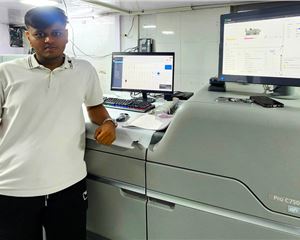Cushrow Jassawala: Printing firms are seeing a buoyancy
The commercial print industry in India remains unorganised and hugely fragmented. Book publishers world-wide are seeking to grow their relationships with established printers who can provide consistent quality and on-time delivery while demonstrating ethical behaviour.
20 Apr 2023 | By PrintWeek Team
For printers this is hard work, changing paradigms while remaining sharply focussed on key business objectives. Indian print firms therefore, need to remain aligned to fundamental customer requirements. Never rest on past laurels. There is enough and more business for such printers to keep growing profitably, irrespective of the changes in the print and publishing scenario.
Printers must stick to their core competence, invest wisely, provide unique value and remain focused on delivering customer delight. Printers will also need to select their verticals and organize their equipment and capabilities to cater to that product/customer segment, be they school books, trade books, commercial printing or packaging. Foreign markets are another avenue to grow business with immense opportunities but long lead times.
Single colour digital printing has seen enormous traction over the last few years with a few digital printers monopolising the space. It's grown on the back of big trade book publishers and is finding acceptance with other segments. Single book production is growing in demand. Investment in inkjet printing is still a deterrent to new players. The cost of printing in single colour for small print runs below 300, using offset machines still challenges inkjet printing cost. And hence the growth in this market may not be at its tipping point yet. Inkjet printing in four-colour space is nascent.
Innovation with commercial printers is demonstrated in aligning with cutting edge printing and pre-press technologies, low-cost automation in post printing processes, using technology to reduce in-line defects, identifying defect free inks for different papers, glues and lamination films best suited for different applications, etc. Commercial printers need to have robust processes to improve productivity, enhance quality, cut waste and reduce turnaround time. Printers must constantly work on these areas to remain ahead of the curve. Fundamental innovation will remain with the eco-system which manufactures printing machines, binding machines, paper mills and consumables' suppliers.
Automation encompasses the selection of technologies from vendors that eliminates manual intervention, ensures consistency in process, predictability in operations and makes available essential information for management decisions. Our acquisition in 2022 at Thomson Press, is an eight-colour RMGT Machine with state of the art in-line colour control system, with auto plate mounting and LED lamps for curing ink on matte paper. Automation also includes low-cost automation in post printing operations, in packing and in reducing manual operations where investment in large machines are not feasible. Above all, automation includes updating ERP to integrate departments and processes and getting cutting edge workflow in pre-press.
It is naive to think of the printing industry as focused on printing technology alone. Printing is one small aspect of a well produced book. It is essential but not sufficient. Any printer in commercial or digital printing understands that the complexity and challenge does not lie in printing but in managing the job from end to end. Printing per se is a fascinating technology and printers need to understand the science and chemistry behind high quality printing. Beyond this, print organisations must go into the details of every process that impacts paper, from precise folding, to lamination, die cutting, index cutting, gilding, foiling, spot or flat UV, cutting, binding, packing and even flawless dispatch to customers' warehouses. A well printed book with any subsequent defect observed by customers is a bad book, and will get no acclaim. Printers need to know how to use the best available technologies, exciting as they are, and integrate them into their supply chain. It’s all about great planning and simple execution. Ensuring "first time right" quality, at every stage of the value chain from vendor receipt to delivery is key. One small defect is enough to ruin an otherwise great job.
Pragmatic printers will not lay blame on the system. They will look at working around and in spite of the system. More importantly they will establish organisational capabilities and employee competencies, that meet evolving and demanding customer expectations. Progressive printers will deliver outstanding service which is on time, in full quantity, of consistently good quality, job after job. Irrespective of the age of an organisation, it is leadership, strategy, strong customer orientation, building competencies, along with a focus on results, which are hallmarks of winners in any industry.
I have learnt immensely from hindsight. Every failure is an opportunity to improve. While I cannot speak for the industry, within Thomson Press, we are constantly reinventing ourselves, relentlessly working to improve and never resting. Some of our decisions and investments have gone awry. We learn from our mistakes and work hard not to repeat them. We are continuously surfacing false assumptions, contesting and invalidating them. All we need is an open mind, a yearning to learn and demonstrate progress in our performance, every day












 See All
See All